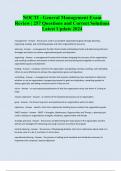College aantekeningen
Summary of chapters 1 & chapters 6-8 of Natural Resource and Environmental Economics
- Vak
- Instelling
- Boek
This document provides a summary of chapters 1 and 6-8 of the textbook Natural Resource and Environmental Economics. They specifically provide extra information required from the reading not covered in class (they help aide class note understanding)
[Meer zien]














